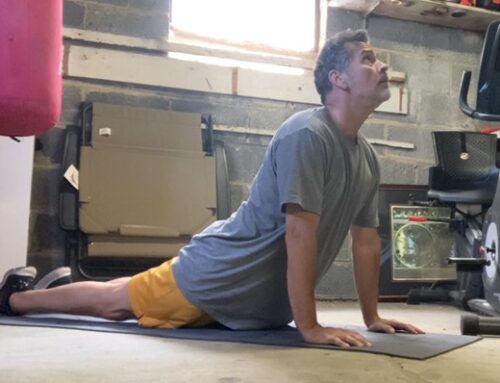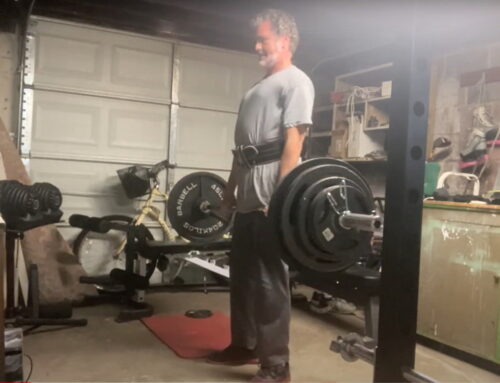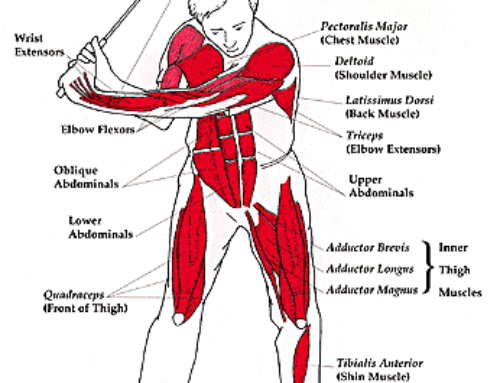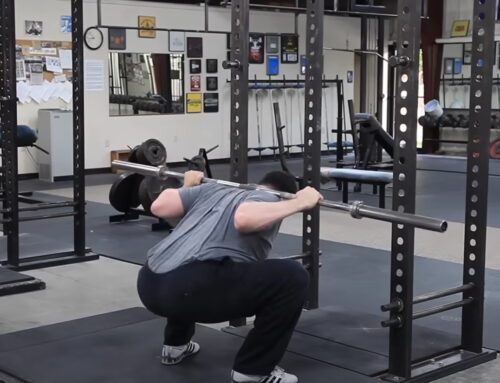
Lat Pull Down
Weight lifting for golfers should be no different than it is for any other athlete.
Yet, the golf fitness community seems reluctant to employ traditional barbell training with their golf clients.
This is mainly because most golf fitness trainers have not learned how to properly perform the basic barbell lifts themselves, let alone teach them to clients.
Teaching the barbell lifts discussed below is really no different than teaching the golf swing. But, I digress.
Since the golf swing is a complex, athletic movement pattern, it is critical to engage in general strength training to train the entire body.
The absolute best tool for training for general strength is the barbell.
What follows is a weight training program for golfers of any age.
Muscles used in the golf swing
 Before we dive into a basic weight training routine for golfers, it’s important to understand what muscles are used in the golf swing.
Before we dive into a basic weight training routine for golfers, it’s important to understand what muscles are used in the golf swing.
The golf swing is a total body movement.
Since we are standing up, it goes without saying that the leg muscles play a critical role.
The calf muscles and the small muscles in the feet are critical for maintaining our balance in the swing.
The quadriceps, glutes, upper back, shoulders, chest and forearms are the most important muscles for generating power.
The hamstrings, lower back, abdominals and other muscles of the core are critical for maintaining our posture, and to a lesser extent, generating power.
The best strength exercises for golf
The best strength exercises for golf are no different than for training for another sport.
If we want to build significant overall strength, we want to focus on big compound movements that train multiple muscle groups and joints.
These movements can be loaded with the most weight.
As a result, the central nervous system gets a stronger signal that it will from exercises where we are training with light weight.
This triggers the body to adapt by building muscle, increasing bone density and improving the strength of our connective tissues in the joints.
The four best exercises for developing general strength are the squat, deadlift, bench press and overhead press.
A couple of additional pulling exercises such as pull-ups and bent over rows are added to the program.
Combined, these exercises train all of the key muscles used in the golf swing.
Weight lifting for golfers – a starting program
The program I started training a couple years ago is based upon the Starting Strength program developed by Mark Rippetoe.

This is me, deadlifting in my garage
Prior to learning this program, I had trained a variety of other programs off and on since my high school years over 40 years ago.
I first started with a beginner program offered by the iconic York Barbell, since their facility was located about twenty miles from where I grew up.
In college, I learned a different routine that was somewhat similar to the novice Starting Strength model.
Later on, I learned the Body For Life program developed by Bill Phillips, and a few years after, like just about every other 40 year old at the time, I trained P90X.
While I still incorporate some of those programs into my overall training now and then, the Starting Strength model is far superior for developing significant strength over a fairly short period of time.
Novice Linear Progression
While the aforementioned exercises are the best for building strength over a short period of time, it is necessary to employ certain programming principles in order to allow this to work.
First, you don’t start training with heavy weight right away. That is how people get injured, which causes them to be discouraged from training.
It is necessary to learn the movements while using conservative weights.
We then employ the principle of progressive overload in order to build strength.
With every workout, for as long as possible, we add a little bit of weight to the bar.
To build strength, we want to exploit the Stress-Recovery-Adaptation cycle.
This means we train one day, rest the next day, then add a little weight to the bar for the next workout.
A linear progression occurs when a trainee is capable of sustaining consistent increases in workload in successive training sessions for a period of time.
For many trainees, this period of time typically lasts from four to six months.
The basic weight lifting program for golfers goes like this…
Workout A
Squat, Bench Press, Deadlift
Workout B
Squat, Overhead Press, Deadlift
These workouts are alternated, so that over a two week cycle, each workout is performed three times.
In week 1, you do Workout A on Monday, Workout B on Wednesday and Workout A again on Friday.
In week 2, you do Workout B on Monday, Workout A on Wednesday and Workout B again on Friday.
After a period of time, we then swap out the deadlift with a different pulling exercise, such as pull-ups. A trainee who can’t do pull-ups will do lat pulldowns.
Sets and Reps
 To build strength, we need to expose our body to intensity, or heavy weight. As a result, we tend to train with fewer reps.
To build strength, we need to expose our body to intensity, or heavy weight. As a result, we tend to train with fewer reps.
Starting out, our focus is on five reps.
Here’s why…
Consider the two ends of the spectrum when it comes to training.
At the low end is 1 rep, and at the high end, we’ll use 20 reps. 20 reps is often employed by the bodybuilding community, which is focused on muscle hypertrophy.
Powerlifters train to have the ability to lift a maximum weight for a single rep. This is effectively just a performance.
A true one rep maximum weight will likely require so much effort, that the rep may take 5 to 7 seconds to complete.
After completing that rep, it will be impossible to immediately complete a second rep at that weight.
At the other end of the spectrum is the 20 reps.
Now, after you’ve completed 20 reps, chances are, if you take a couple deep breaths, you can squeeze out another rep or two.
At this point, it is no longer maximum force production at work, but muscle endurance.
In between this rep range is a number that will result in the following training adaptations:
- Increased strength
- Increased muscle mass
- Improved conditioning
That rep range is right around five reps.
After you’ve been training for a couple months and the weight on the bar has increased quite a bit, you will find that pushing out the fifth rep will be quite difficult.
It may take you a few seconds to complete the rep, and once done, you will be huffing and puffing, particularly after a heavy set of squats or deadlifts.
 In general, novice lifters will make significant gains in strength over the span of a few months simply by performing THREE working sets of FIVE reps.
In general, novice lifters will make significant gains in strength over the span of a few months simply by performing THREE working sets of FIVE reps.
The lone exception is that we initially only train one working set of five reps on the deadlift, since it puts more stress on the nervous system than the other lifts.
This is due to the weight on the bar and the number of muscle groups involved in the lift.
Before the working sets, we do several warm-up sets.
Here is an example workout for the squat…
Set 1 – Empty Bar – 10 reps with focus on form
Set 2 – 95 pounds – 5 reps
Set 3 – 135 pounds – 3 reps
Set 4 – 155 pounds – 1 rep
Set 5 – 175 pounds – 1 rep
Set 6 – 195 pounds – 1 rep
Sets 7-9 – 205 pounds – 5 reps
For the warm up sets, you only rest for the time it takes to change the weight on the bar.
For the three working sets, you will rest for about 2 to 3 minutes.
Over time, as the weight on the bar gets much heavier, you’ll need upwards of five minutes between sets.
This is particularly true for the squat, since it employs so much muscle mass.
Eventually, performing three working sets of five reps will prove to be too difficult because we’ve added considerable weight to the bar over a fairly short period of time.
That is when adjustments to the training will occur.
This typically begins with the overhead press first, since it is the most difficult lift and the lift in which you will eventually lift the least amount of weight.
Final Thoughts
 Weight lifting for golfers is no different than how it should be for the general public.
Weight lifting for golfers is no different than how it should be for the general public.
Golfers need general strength as much as anyone, and it really makes no sense to focus on “golf specific” exercises that won’t help achieve that goal.
This is why I recommend any golfer who wants to improve their performance on the golf course to follow the two factor model of performance… train for strength, practice golf.
Once you’ve gotten through the Novice Linear Progression, you can then focus on building speed with some different training.
However, you should always continue to train for strength going forward, even if on a reduced schedule.
Want to learn more? Check out my Strength and Fitness training program.
If your goal is to train from home, be sure to check out the Necessities for a Home Golf Gym.
You can learn how to perform each of the four main strength training exercises by watching the videos below.
Now, get to work!





